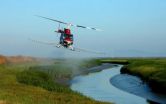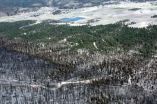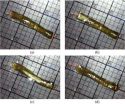(Press-News.org) What should resource managers do when the eradication of an invasive species threatens an endangered one?
In results of a study published this week in the journal Science, researchers at the University of California, Davis, examine one such conundrum now taking place in San Francisco Bay.
The study was led by UC Davis researcher Adam Lampert.
"This work advances a framework for cost-effective management solutions to the conflict between removing invasive species and conserving biodiversity," said Alan Tessier, acting deputy division director in the National Science Foundation's (NSF) Directorate for Biological Sciences, which supported the research through NSF's Dynamics of Coupled Natural and Human Systems (CNH) Program.
CNH is also co-funded by NSF's Directorates for Geosciences and Social, Behavioral & Economic Sciences.
"The project exemplifies the goals of the CNH program," says Tessier, "which are to advance the understanding of complex systems involving humans and nature."
The California Clapper Rail--a bird found only in San Francisco Bay--depends on an invasive salt marsh cordgrass, hybrid Spartina, as nesting habitat.
Its native habitat has slowly vanished over recent decades, largely due to urban development and invasion by Spartina.
Study results show that, rather than moving as fast as possible with eradication and restoration plans, the best approach is to slow down the eradication of the invasive species until restoration or natural recovery of the system provides appropriate habitat for the endangered species.
"Just thinking from a single-species standpoint doesn't work," said paper co-author and UC-Davis environmental scientist Alan Hastings.
"The whole management system needs to take longer, and you need to have much more flexibility in the timing of budget expenditures over a longer time-frame."
The scientists combined biological and economic data on Spartina and on the Clapper Rail to develop a modeling framework to balance conflicting management goals, including endangered species recovery and invasive species restoration, given fiscal limitations.
While more threatened and endangered species are becoming dependent on invasive species for habitat and food, examples of the study's specific conflict are relatively rare--for now.
Another case where the eradication of an invasive species threatened to compromise the recovery of an endangered plant or animal is in the southwestern United States, where an effort to eradicate Tamarisk was cancelled because the invasive tree provides nesting habitat for the endangered Southwestern Willow Flycatcher.
"As eradication programs increase in number, we expect this will be a more common conflict in the future," said paper co-author and UC Davis scientist Ted Grosholz.
INFORMATION:
Other co-authors include scientists James Sanchirico of UC Davis and Sunny Jardine of the University of Delaware.
Eradicating invasive species sometimes threatens endangered ones
Study of California Clapper Rail and salt marsh cordgrass Spartina offers new insights
2014-05-30
ELSE PRESS RELEASES FROM THIS DATE:
New NASA/JAXA precipitation satellite passes check-out, starts mission
2014-05-30
The new Global Precipitation Measurement Core Observatory satellite is now in the hands of the engineers who will fly the spacecraft and ensure the steady flow of data on rain and snow for the life of the mission. The official handover to the Earth Science Mission Operations team at NASA's Goddard Space Flight Center in Greenbelt, Maryland, on May 29, marked the end of a successful check-out period.
The Global Precipitation Measurement (GPM) mission is a joint mission between NASA and the Japan Aerospace Exploration Agency. Its Core Observatory launched on Feb. 27, 2014, ...
Wallow Fire study suggests there may be multiple paths to fuel reduction in the WUI
2014-05-30
Conservative fuel treatments designed to reduce fire severity while still providing forest cover and wildlife habitat worked equally as well as more intensive treatments in allowing for the protection of homes during the 2011 Wallow Fire, a study published in the journal Forest Ecology and Management has found. The distance into the treated area where fire severity was reduced varied, however, between these different thinning approaches where fuels were reduced. The findings suggest that there may be multiple paths to fuel treatment design around the wildland-urban interface ...
A first for NASA's IRIS: Observing a gigantic eruption of solar material
2014-05-30
VIDEO:
A coronal mass ejection burst off the side of the sun on May 9, 2014. The giant sheet of solar material erupting was the first CME seen by NASA's Interface...
Click here for more information.
A coronal mass ejection, or CME, surged off the side of the sun on May 9, 2014, and NASA's newest solar observatory caught it in extraordinary detail. This was the first CME observed by the Interface Region Imaging Spectrograph, or IRIS, which launched in June 2013 to peer into ...
Myriad presents data on BRACAnalysis CDx and HRD at 2014 ASCO meeting
2014-05-30
SALT LAKE CITY, Utah, May 30, 2014 – Myriad Genetics, Inc. (NASDAQ: MYGN), a global leader in molecular diagnostics, announced the presentation of new data at the American Society of Clinical Oncology (ASCO) meeting this week that supports the clinical efficacy of its BRACAnalysis CDx™ and HRD™ tests in predicting platinum based therapy response for breast cancer patients. Additionally, the company is providing an update on key commercial milestones that underscore its commitment to the field of companion diagnostics.
"Myriad is committed to advancing the science of companion ...
New method of wormlike motion lets gels wiggle through water
2014-05-30
Next time you spot an earthworm sliding through fresh dirt, take a closer look. What you're seeing is an organic movement called peristaltic locomotion that has been meticulously refined by nature.
Jarod Gregory, an undergraduate student in the University of Cincinnati's College of Engineering and Applied Science, used a worm's contracting and expanding motion to provide a way for gels to swim in water. This is a product of work by the interdisciplinary team consisting of Jarod Gregory, a chemical engineering major, and his two advisers, Lilit Yeghiazarian, assistant ...
New drug treatment helps prevent early menopause in breast cancer patients
2014-05-30
MAYWOOD, Ill. (May 30, 2014) – Among young women treated for breast cancer, one of the most distressing side effects of chemotherapy is early menopause. But a major clinical trial has found that the risk of early menopause can be significantly reduced by adding a drug called goserelin to the chemotherapy regimen. Also, women who took goserelin and wanted to have children were more likely to get pregnant and deliver a healthy baby.
Results were released during the 2014 American Society of Clinical Oncology 50th Annual Meeting in Chicago. Kathy Albain, MD, of Loyola University ...
Stopping statins may benefit terminally ill patients
2014-05-30
Results presented today at the 50th Annual Meeting of the American Society for Clinical Oncology (ASCO) and June 6 at the European Association of Palliative Care Research Conference show that stopping statins for cholesterol management in the late stages of cancer or other terminal illnesses may offer quality-of-life and even life-extending benefits. The results highlight the larger question of when, if ever, it is appropriate in patients with life-limiting illnesses to discontinue medications prescribed for other conditions that will likely not lead to their death.
Researchers ...
Women with metastatic breast cancer can safely receive bisphosphonates less frequently, without comp
2014-05-30
CHICAGO – Women with metastatic breast cancer to the bone may be able to receive bisphosphonates, the bone-targeting class of drugs like zoledronic acid, less often after the first year of monthly administration. With that practice change, women may also reduce their risk of serious side effects, according to a study led by researchers at The University of Texas MD Anderson Cancer Center.
The research was presented today on the press program of the American Society of Clinical Oncology 2014 Annual Meeting by MD Anderson's Gabriel Hortobagyi, MD, professor, Breast Medical ...
Phase I study of DMOT4039A in patients with pancreatic or ovarian cancer
2014-05-30
A study presented at the 50th Annual Meeting of the American Society for Clinical Oncology (ASCO) describes the results of a phase I clinical trial of the investigational agent DMOT4039A against pancreatic and ovarian cancers. In this early clinical trial with the goal of identifying possible risks and defining likely dosages, the drug was well tolerated and in some patients showed initial evidence of anti-cancer activity.
The drug is in fact a combination of a chemotherapeutic agent with an antibody, technically called an antibody-drug conjugate (ADC). Just as cells ...
Genetic profile predicts which bladder cancer patients will benefit from early chemotherapy
2014-05-30
CHICAGO, IL (May 30, 2014)—Three genetic changes can predict whether a patient will benefit from chemotherapy before surgery to remove bladder cancer, according to new findings presented by Fox Chase Cancer Center researchers during the 50th Annual Meeting of the American Society of Clinical Oncology.
During the study, 36 patients with muscle-invasive bladder cancer received chemotherapy before surgery, consisting of an accelerated regimen of methotrexate, vinblastine, doxorubicin, and cisplatin (AMVAC). By the time surgery rolled around, 14 patients appeared cancer-free. ...
LAST 30 PRESS RELEASES:
iPS cells from dish to freezer and back
Deep neural networks enable accurate pricing of American options under stochastic volatility
Collective risk resonance in Chinese stock sectors uncovered through higher-order network analysis
Does CPU impact systemic risk contributions of Chinese sectors? Evidence from mixed frequency methods with asymmetric tail long memory
General intelligence framework to predict virus adaptation based on a genome language model
Antibiotic resistance is ancient, ecological, and deeply connected to human activity, new review shows
Vapes, pouches, heated tobacco, shisha, cigarettes: nicotine in all forms is toxic to the heart and blood vessels
From powder to planet: University of Modena engineers forge a low-carbon future for advanced metal manufacturing
Super strain-resistant superconductors
Pre-school health programme does not improve children’s diet or physical activity, prompting call for policy changes, study finds
Autumn clock change linked to reduction in certain health conditions
AI images of doctors can exaggerate and reinforce existing stereotypes
Where medicine meets melody – how lullabies help babies and parents in intensive care
We may never be able to tell if AI becomes conscious, argues philosopher
AI video translation shows promise but humans still hold the edge
Deep ocean earthquakes drive Southern Ocean’s massive phytoplankton blooms, study finds
Without campus leftovers to pick through, the beaks of this bird changed shape during the pandemic
High-dose antibiotic does not reduce mortality in tuberculous meningitis
How many insects fly in the sky above the USA?
Could cheese protect your brain health?
Who faces more difficulty recovering from stroke?
Colliding galaxies create the brightest, fastest growing black holes at their center
New BrainHealth research reveals tradeoffs on sleep with cannabis use for chronic pain
Aging-US now on ResearchGate, enhancing visibility for authors and readers
'Molecular glue' stabilizes protein that inhibits development of non-small cell lung cancer
Mount Sinai Health System is recognized in 2025 Chime Digital Health Most Wired survey
From prey to predator: How carnivores spread beneficial fungi
Menopause symptoms may be frequent and have negative effects, according to female endurance athletes
US Congressmembers’ responses on X to mass shooting events differ along party lines
KAIST-UEL team develops “origami” airless wheel to explore lunar caves
[Press-News.org] Eradicating invasive species sometimes threatens endangered onesStudy of California Clapper Rail and salt marsh cordgrass Spartina offers new insights









